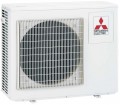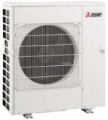Power consumption (cooling/heating)
Power consumption of the air conditioner in cooling and heating mode; for models without a heating mode, only one number is given. This parameter should not be confused with the effective capacity of the air conditioner. Effective capacity is the amount of heat that the unit can "pump" into the environment or the room. This item also indicates the amount of electricity consumed by the device from the network.
In all air conditioners, the power consumption is several times lower than the effective capacity. It is due to the peculiarities of the operation of such units. At the same time, devices with the same efficiency may differ in power consumption. In such cases, the more economical models usually cost more, but with continued use, the difference can quickly pay off with less electricity consumption.
Also, two points related to electrical engineering depend on this nuance. Firstly, power consumption affects power requirements: models up to 3 – 3.5 kW can be connected to a regular outlet, while higher power consumption requires a three-phase connection (see below). Secondly, the power consumption is needed to calculate the load on the mains and the necessary parameters of additional equipment: stabilizers, emergency generators, uninterruptible power supplies, etc.
Noise level (max/min)
The maximum and minimum level of noise produced by the air conditioner during operation; for split and multi split systems (see "Type"), by default, it is indicated for the indoor unit, and the data for the outdoor unit can be specified in the notes.
The noise level is indicated in decibels; this is a non-linear unit, so it is easiest to evaluate this parameter using comparative tables — they can be found in special sources. Here we note that, according to sanitary standards, the maximum level of constant noise for residential premises is 40 dB during the day and 30 dB at night; for offices, this figure is 50 dB, and in industrial premises higher volume levels may be allowed. So it is worth choosing an air conditioner according to this indicator, taking into account where and how it is planned to use it.
As for specific numbers, among the quietest modern air conditioners, there are models with a minimum performance of
23 – 24 dB,
22 – 21 dB, and sometimes even
20 dB or less. However, units at
31 – 31 dB and
33 – 34 dB are not uncommon; such loudness, usually, does not create discomfort in the daytime, but at night it is no longer desirable. However, in some cases, a louder air conditioner may be the best choice: noise reduction affects the cost, sometimes quite noticeably, and if the device
...is not planned to be turned on at night, you can not overpay for additional noise reduction.Refrigerant type
The type of refrigerant used in the air conditioner.
The refrigerant is a volatile liquid that transfers heat between the outdoor unit(s) and the indoor unit(s). In common parlance, such compounds are also called freons, although this is not entirely technically correct. The type of refrigerant is most important when buying air conditioner units separately — for example, to assemble a multi split system (see "Type"): all units must use the same type of freon, otherwise they will be incompatible. However, there are quite noticeable physical differences between different compositions, sometimes quite important.
The most common refrigerants nowadays are
R22,
R32,
R407C,
R410A, R134A and R290, here is a more detailed description of them:
— R22. The "oldest" of the varieties of refrigerant found nowadays. It is distinguished by its low cost, and low operating pressure (which has a positive effect on the reliability and price of the cooling circuits themselves). And uniform composition, which makes it possible not to change it entirely in case of a refrigerant leak, but simply replenish the system with the required amount of liquid. However, R22 is environmentally unsafe (mainly for the ozone layer), which is why nowadays it is gradually being replaced by more advanced compounds.
— R32. A fairly advanced refri
...gerant that combines three key advantages: efficiency, environmental friendliness and uniformity. So, air conditioners under R32 can be made quite compact and, at the same time, powerful; this substance does not destroy the ozone layer and does not have a significant effect on global warming; and a homogeneous composition allows you to refuel the air conditioner without problems in case of a leak. The main disadvantage of models with this type of refrigerant is the high price associated not so much with the cost of the R32 itself but with the specific requirements for the design of the refrigeration circuit.
— R407C. A refrigerant designed as a safe alternative to R22; does not affect the ozone layer. At the same time, such a composition is much more expensive; its working pressure is slightly higher, which requires a greater strength of the cooling circuit (although not as high as for R410A); and polyester oil used with R407C tends to absorb moisture and lose properties. In addition, this filler is zeotropic (heterogeneous in composition): its components have different boiling points and different evaporation rates. As a result, even with a small leak, the refrigerant loses its properties, and the situation can be corrected only by a complete refilling of the air conditioner.
— R410A. Another green alternative to R22. Unlike R407C, it is azeotropic — it consists of components with the same evaporation specs; so in the event of a leak, the ratio of these components does not change, in which case refilling the circuit is allowed instead of completely replacing the contents. On the other hand, R410A is characterized by high operating pressure, which puts serious demands on the strength and reliability of the cooling circuit and increases its cost; and the refrigerant itself is quite expensive.
— R134A. One of the modern refrigerants with advanced properties. It is completely homogeneous, like R22, but at the same time, it is safe for the ozone layer and is characterized by a low coefficient of influence on global warming. The disadvantage of this composition is traditional — high cost; in addition, it uses polyester oil, which is prone to moisture absorption.
— R290. Liquefied propane is used as a refrigerant. It has several advantages: non-toxic, environmentally friendly (zero impact on the ozone layer, minimal impact on global warming), homogeneous (i.e. does not require complete replacement in case of leakage, it is enough to replenish the missing amount), used with mineral oil, which is insensitive to moisture. In addition, propane has a low operating pressure, which simplifies the design of circuits and reduces their cost, as well as a low temperature at the outlet of the compressor, which contributes to efficiency. This refrigerant has two disadvantages: flammability and high compressor power requirements, which makes such units quite heavy and bulky. Therefore, despite all the advantages, R290 is used quite rarely.Seasonal cooling SEER
The seasonal SEER cooling factor provided by the air conditioner.
The meaning of this parameter is similar to the cooling coefficient — EER (see above): we are talking about the ratio of useful power to spend, and the higher the coefficient, the more efficient the device is. The difference between these parameters lies in the measurement method: EER is measured for strictly standard conditions (outside temperature +35 °C, workload 100%), while SEER is closer to reality — it takes into account seasonal temperature fluctuations (for Europe) and some other specific points, such as the increased efficiency of inverter compressors. Therefore, since 2013, it is customary to use SEER as the main parameter in the EU; this parameter was also adopted for air conditioners supplied to other countries with a similar climate.
Seasonal heating SCOP
Seasonal heating coefficient SCOP provided by the air conditioner.
Like the COP (see above), this parameter describes the overall efficiency of the air conditioner in heating operation and is calculated by the formula: thermal (useful) power divided by electricity consumption. The higher the coefficient, the more efficient the device, respectively. And the difference between COP and SCOP is that COP is measured under strictly standard conditions (outside temperature +7 °C, full workload), and SCOP takes into account seasonal temperature fluctuations (for Europe), changes in air conditioner operating modes, the presence of an inverter and some other options. Thanks to this, SCOP is closer to real indicators, and since 2013 this coefficient has been taken as the main one in the territory of the European Union. However, this parameter is also used for air conditioners supplied to other countries with a similar climate.
Energy efficiency SEER (cooling)
The seasonal energy efficiency class that the air conditioner complies with in cooling operation. Initially, this parameter was designated in letters from
A(the most economical indicator) to G (the most expensive); however, more efficient classes than A appeared later —
A+,
A++ and
A+++(the more pluses, the higher the energy efficiency).
This parameter is directly related to the value of the SEER coefficient. For more information on this factor and how it differs from the EER, see "Seasonal Cooling SEER Ratio". Here we note that each class has its range of SEER values; detailed correspondence tables can be found in special sources.
Other things being equal, more energy-efficient air conditioners are more expensive, but the difference can be recouped as it uses less electicity.
Energy efficiency SCOP (heating)
The seasonal energy efficiency class that the air conditioner complies with when operating for heating. Initially, this parameter was designated in letters from
A(the most economical indicator) to G (the most expensive); however, more efficient classes than A appeared later —
A+,
A++ and
A+++(the more pluses, the higher the energy efficiency).
This indicator is directly related to the value of the SCOP coefficient. For more information about this coefficient and how it differs from the COP, see "Seasonal heating SCOP". Here we note that each class has its range of SCOP values; detailed tables can be found in special sources.
Other things being equal, more energy-efficient air conditioners are more expensive, but the difference can be recouped as it uses less electricity.
Maximum T for cooling mode
The highest outdoor air temperature at which normal operation of the air conditioner in normal cooling mode is possible.
It should be noted that for basic models of home climate equipment, the max outdoor air temperature for cooling is usually +43 °С. Advanced models of air conditioners remain operational at +50 °С and even at +55 °С (which almost reaches the absolute maximum air temperature on our planet).
Maximum height difference between units
The maximum height difference allowed for split system units. For multi splits (see "Type"), in this case, we mean the difference in height between the highest and lowest unit.
When installing units at different heights, a pressure difference arises in the system — the greater the height difference, the greater this difference, and if it is too large, the system will not be able to work normally.

